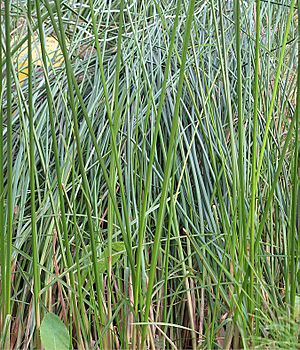Jointed flatsedge facts for kids
Quick facts for kids Jointed flatsedge |
|
|---|---|
 |
|
| Cyperus articulatus | |
| Conservation status | |
| Scientific classification | |
| Genus: |
Cyperus
|
| Species: |
articulatus
|
| Synonyms | |
|
List
|
|
Cyperus articulatus is a special kind of plant known as a sedge. People call it jointed flatsedge or priprioca. It's also sometimes called Guinea rush. This plant is a perennial herb, meaning it lives for many years. It loves water and grows in or near rivers, streams, lakes, and swamps. You can find it in warm, tropical, and subtropical places all over the world, like Africa, southern Asia, northern Australia, the southeastern United States, the West Indies, and Latin America.
Contents
What Does Priprioca Look Like?
This plant looks a lot like another sedge called C. corymbosus. However, Cyperus articulatus has stems that are round and hollow. These stems have sections inside that are about 5–20 mm long.
Unlike many plants, it doesn't have regular leaves. Instead, it has small, scale-like parts near its flowers. The parts of the flower that produce pollen, called anthers, are about 1.0-1.5 mm long. The small, leaf-like parts that protect the flowers, called glumes, are 2.25 to 3.5 mm long.
How People Use Priprioca
Priprioca is related to other nut sedges, like the tigernut. The roots of priprioca have a unique smell. It's light, woody, and a bit spicy, with hints of flowers.
Priprioca in the Amazon
This plant is a traditional spice in the Amazon region. People there have used it for a long time in their local traditions. Its reddish essential oil is also used by companies. The cosmetic industry uses it for perfumes and other products. More and more, it's also being used to add flavor to food.
Other Uses and Properties
Just like its relative papyrus, the fibers and underground stems (called rhizomes) of priprioca are used to make crafts. These crafts not only smell wonderful but are also strong. They can resist mold, which might mean the essential oil has properties that fight fungi.
The oil from priprioca is very complex. It contains many different natural chemicals. Some of the main ones include muskatone, alpha-Pinene, beta-Pinene, and caryophyllene oxide.
The Story of Priprioca
There's a cool story from Brazilian folklore about how priprioca got its name. It's about a brave warrior named Piri-Piri. He lived in an indigenous village deep in the Amazon rainforest.
Piri-Piri's Special Scent
The story says that Piri-Piri had an amazing smell. This scent was so wonderful that it could attract any indigenous tribe. He also had a special power: he could disappear in a cloud if he was in danger. This power also helped him get away from all the girls who were interested in him!
The Shaman's Daughter
One day, the daughter of a shaman named Supi fell deeply in love with Piri-Piri. She really wanted to be with him. So, she asked her father to teach her a spell to capture Piri-Piri.
The shaman told her what to do. On a night with a full moon, she needed to tie Piri-Piri's feet with her hair. Piri-Piri, sensing danger, used his power. He disappeared in a cloud and was never seen again.
The Birth of Priprioca
In the exact spot where the warrior Piri-Piri was last seen, a new plant began to grow. This plant also gave off his magnificent aroma. To honor him, people named this plant piripirioca. Over time, the name was shortened to priprioca, which is what we call it today.
- Cyperus articulatus in West African plants – A Photo Guide.
See also
 In Spanish: Cyperus articulatus para niños
In Spanish: Cyperus articulatus para niños


